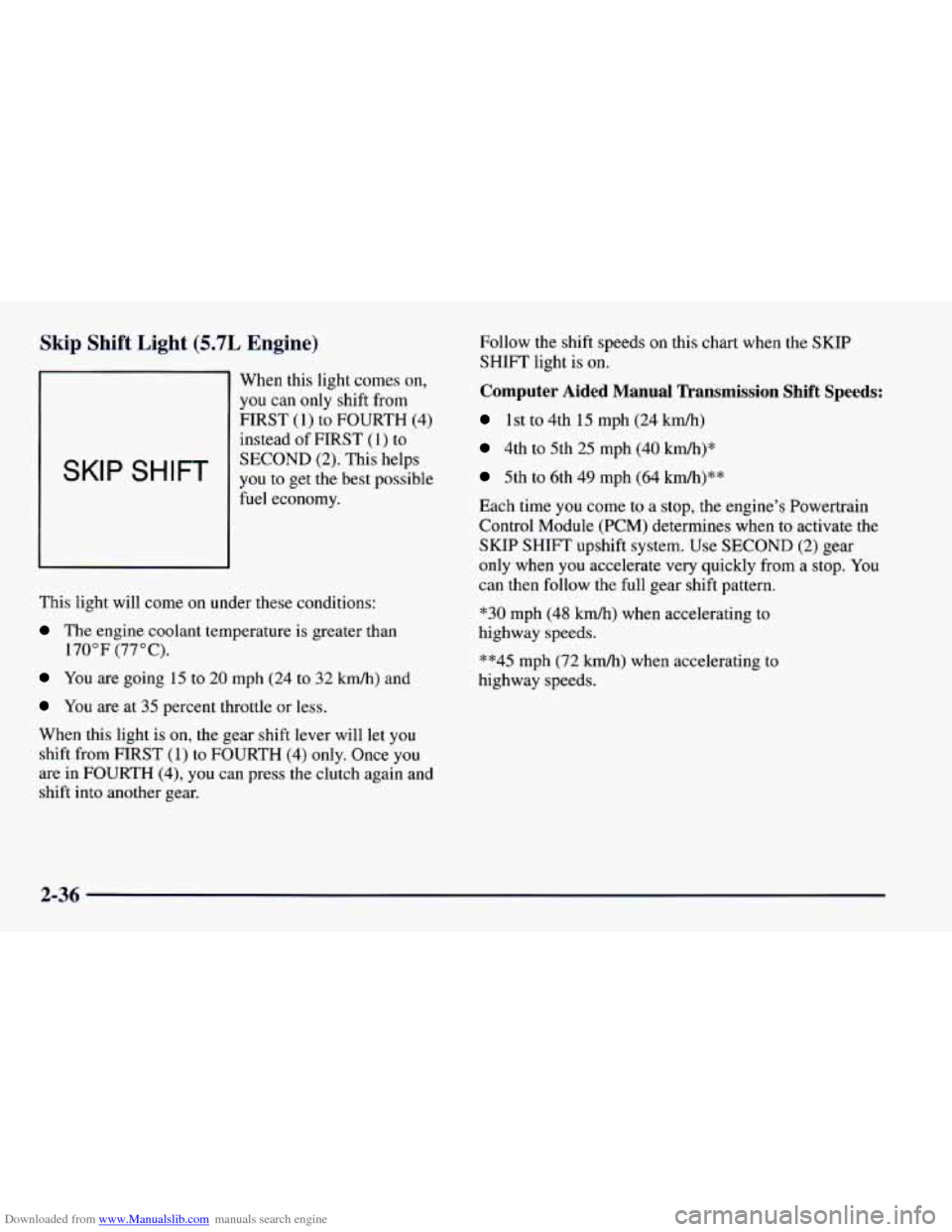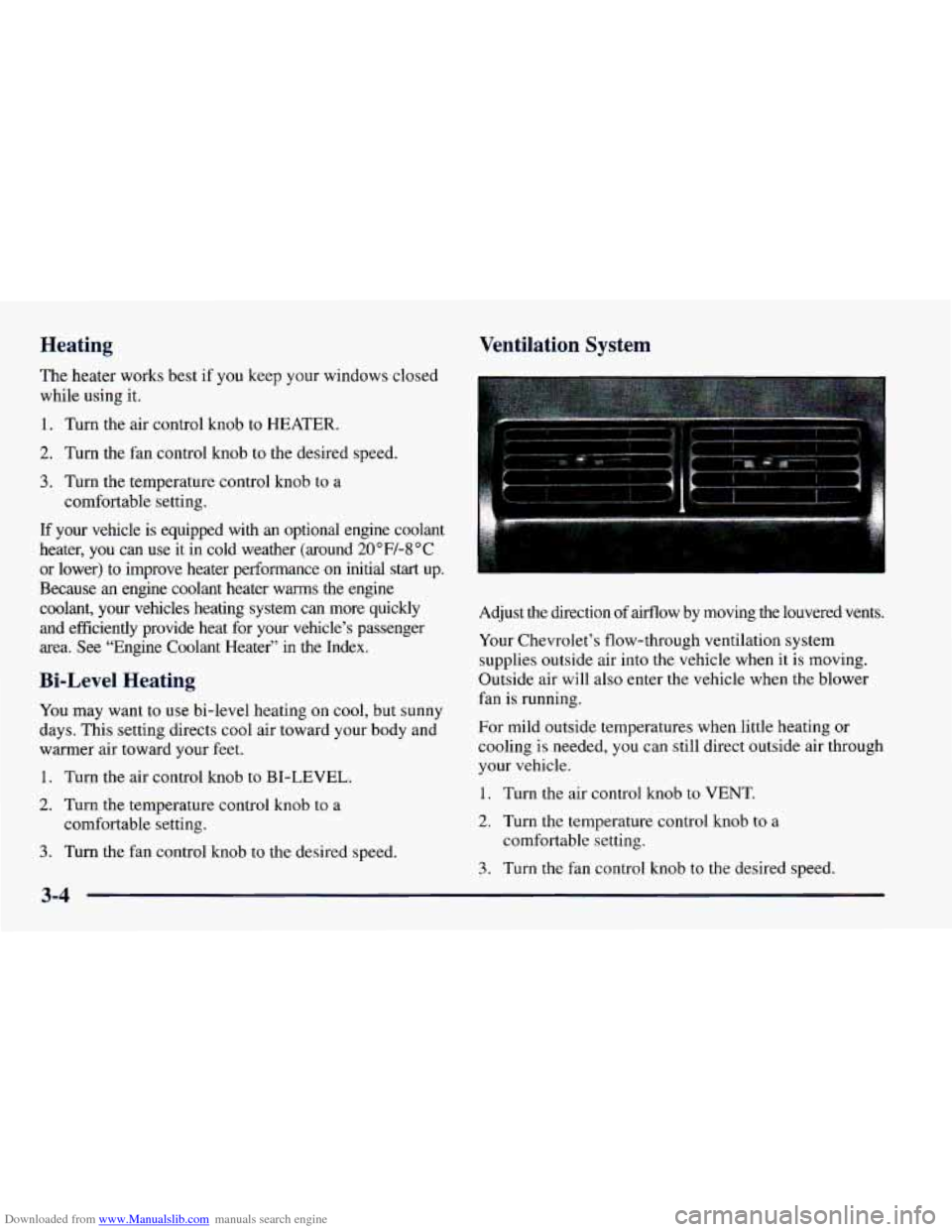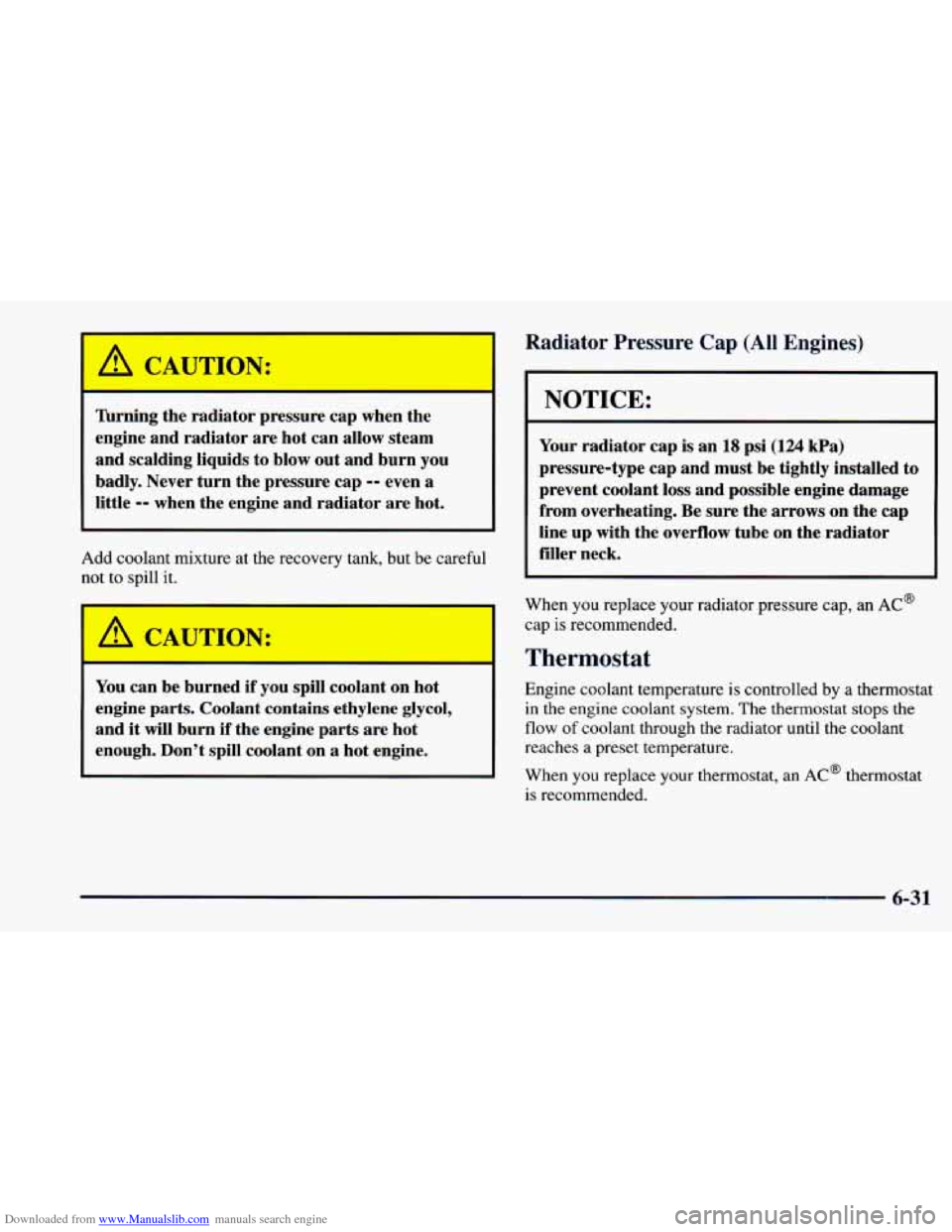1997 CHEVROLET CAMARO coolant temperature
[x] Cancel search: coolant temperaturePage 78 of 404

Downloaded from www.Manualslib.com manuals search engine To Use the Coolant Heater
1. Turn off the engine.
2. Open the hood and unwrap the electrical cord.
3. Plug it into a normal, grounded 1 10-volt AC outlet.
Plugging the cord into an ungrounded outlet
could cause an electrical shock.
Also, the wrong
kind
of extension cord could overheat and cause
a fire. You could be seriously injured. Plug the
cord
into a properly grounded three-prong
110-volt
AC outlet. If the cord won’t reach, use a
heavy-duty three-prong extension cord rated for
at least
15 amps.
4. Before starting the engine, be sure to unplug and
store the cord as
it was before to keep it away from
hot pipes, manifold or moving engine parts. If you
don’t,
it could be damaged.
How long should
you keep the coolant heater plugged
in? The answer depends
on the outside temperature, the
kind
of oil you have, and some other things. Instead of
trying to list everything here, we ask that you contact
your Chevrolet dealer in the area where you’ll be
parking your vehicle. The dealer can give you the best
advice for that particular area.
2-28
Page 86 of 404

Downloaded from www.Manualslib.com manuals search engine Skip Shift Light (5.7L Engine)
When this light comes on,
you can only shift from
FIRST (1) to FOURTH (4)
instead
of FIRST (1) to
SECOND (2). This helps
you to get the best possible
fuel economy.
This light will come on under these conditions:
The engine coolant temperature is greater than
170°F (77°C).
You are going 15 to 20 mph (24 to 32 km/h) and
You are at 35 percent throttle or less.
When this light is on, the gear shift lever
will rer you
shift from FIRST (1) to FOURTH (4) only. Once you
are in
FOURTH (4), you can press the clutch again and
shift into another gear. Follow
the shift speeds
on this chart when the SKIP
SHIFT light is on.
Computer Aided Manual Transmission Shift Speeds:
1st to 4th 15 mph (24 km/h)
4th to 5th 25 mph (40 km/h)*
5th to 6th 49 mph (64 km/h)**
Each time you come to a stop, the engine's Powertrain
Control Module (PCM) determines when to activate the
SKIP SHIFT upshift system. Use
SECOND (2) gear
only when you accelerate very quickly from a stop.
You
can then follow the full gear shift pattern.
"30 mph (48 km/h) when accelerating to
highway speeds.
**45 mph (72 km/h) when accelerating to
highway speeds.
2-36
Page 133 of 404

Downloaded from www.Manualslib.com manuals search engine Engine Coolant Temperature Gage
1
This gage shows the engine
coolant temperature. If the
gage pointer moves into
the red area, your engine
is approaching an
overheating condition.
Low Coolant Light (V8 Engine)
This warning light should
come on briefly while
you
are starting your engine. If
the light doesn’t come on,
m
If you have been operating your vehicle under normal
driving conditions, you should pull off the road, stop
your vehicle and turn off the road as soon as possible.
In “Problems on the Road” this section shows what
to
do. See “Engine Overheating” in the Index. Your
Camaro is equipped with a
LOW COOLANT
indicator that is designed to detect when the coolant
level drops below the set limit.
If the low coolant level
sensor (on the radiator) detects that the level drops while
the engine is running, the
LOW COOLANT indicator
will light and remain lit until the ignition switch is
turned to the
OFF position. Check the coolant level and
add coolant as needed.
2-83
Page 144 of 404

Downloaded from www.Manualslib.com manuals search engine Heating
The heater works best if you keep your windows closed
while using it.
1. Turn the air control knob to HEATER.
2. Turn the fan control knob to the desired speed.
3. Turn the temperature control knob to a
If your vehicle is equipped with an optional engine coolant
heater,
you can use it in cold weather (around 20 “F/-8 “C
or lower)
to improve heater performance on initial start up.
Because an engine coolant heater warms the engine
coolant, your vehicles heating system can more quickly
and efficiently provide heat for your vehicle’s passenger
area.
See “Engine Coolant Heater” in the Index.
Bi-Level Heating
You may want to use bi-level heating on cool, but sunny
days. This setting directs cool air toward your body and
warmer air toward your feet.
1. Turn the air control knob to BI-LEVEL.
2. Turn the temperature control knob to a
3. Turn the fan control knob to the desired speed.
comfortable
setting.
comfortable setting.
Ventilation System
Adjust the direction of airflow by moving the louvered vents.
Your Chevrolet’s flow-through ventilation system
supplies outside air into the vehicle when it is moving.
Outside air will also enter the vehicle when the blower
fan is running.
For mild outside temperatures when little heating or
cooling is needed, you can still direct outside air through
your vehicle.
1. Turn the air control knob to VENT.
2. Turn the temperature control knob to a
comfortable setting.
3. Turn the fan control knob to the desired speed.
3-4
Page 218 of 404

Downloaded from www.Manualslib.com manuals search engine 'Engine Overheating
You will find a coolant temperature gage on your
Chevrolet's instrument panel. You may also find a LOW
COOLANT warning light on your Chevrolet's
instrument panel.
(V8 Engine Only)
If Steam Is Coming From Your Engine
t A
/! CAUTION:
Steam from an overheated engine can burn
badly, even if you just open the hood. Stay away
from the engine
if you see or hear steam coming
from it. Just turn
it off and get everyone away
from the vehicle until it cools down. Wait until
there
is no sign of steam or coolant before you
open the hood.
If you keep driving when your engine is
overheated, the liquids in it can catch fire. You or
others could be badly burned. Stop your engine
if
it overheats, and get out of the vehicle until the
engine is cool.
I NOTICE:
~~ ~
If your engine catches fire because you keep
driving with no coolant, your vehicle can be
badly damaged. The costly repairs would not be
covered
by your warranty.
5-14
Page 274 of 404

Downloaded from www.Manualslib.com manuals search engine Engine Coolant
The cooling s stem in your vehicle is filled with
DEX-COOL engine coolant. This coolant is designed
to remain
in your vehicle for 5 years or 150,000 miles
(240 000 km) whichever occurs first, if you add only
DEX-COOL’ extended life coolant.
The following explains your cooling system and how to
add coolant when it
is low. If you have a problem with
engine overheating or
if you need to add coolant to your
radiator, see “Engine Overheating” in the Index.
d
A 50/50 mixture of water and DEX-COOL@
coolant will:
0 Give freezing protection down to -34°F (-37°C).
0 Give boiling protection up to 265 “F (1 29°C).
0 Protect against rust and corrosion.
0 Help keep the proper engine temperature.
0 Let the warning lights and gages work as
they should.
NOTICE:
When adding coolant, it is important that you use
only
DEX-COOL@ (silicate-free) coolant.
If silicated coolant is added to the system,
premature engine, heater core
or radiator
corrosion may result. In addition, the engine
coolant
will require change sooner -- at
30,000 miles (50 000 km) or 24 months,
whichever occurs first.
6-28
Page 277 of 404

Downloaded from www.Manualslib.com manuals search engine A CAUTION:
Turning the radiator pressure cap when the
engine and radiator are hot can allow steam
and scalding liquids
to blow out and burn you
badly. Never turn the pressure cap
-- even a
little -- when the engine and radiator are hot.
Add coolant mixture at the recovery tank, but be careful
not to spill it.
'
A CAUTION:
You can be burned if you spill coolant on hot
engine parts. Coolant contains ethylene glycol,
and
it will burn if the engine parts are hot
enough. Don't spill coolant on a hot engine.
Radiator Pressure Cap (All Engines)
NOTICE:
Your radiator cap is an 18 psi (124 kPa)
~ pressure-type cap and must be tightly installed to
~ prevent coolant loss and possible engine damage
from overheating. Be sure the arrows on the cap
line up with the overflow tube on the radiator
filler neck.
When you replace your radiator pressure cap, an AC@
cap
is recommended.
Thermostat
Engine coolant temperature is controlled by a thermostat
in the engine coolant system. The thermostat stops the
flow of coolant through the radiator until the coolant
reaches a preset temperature.
When you replace your thermostat, an AC@ thermostat
is recommended.
6-31
Page 394 of 404

Downloaded from www.Manualslib.com manuals search engine Electrical Equipment. Adding .......... 2.27.3.22. 6.68
Electrical System
............................... 6-68
Engine
.................................. 6-10. 6-11
Coolant ..................................... 6-28
Coolant Heater
............................... 2-27
Coolant Level Check
.......................... 7-43
Coolant Temperature Gage
..................... 2-83
Exhaust
..................................... 2-42
Fuse Blocks
................................. 6-72
Identification
................................ 6-68
Oil Level Check
.............................. 7-43
Overheating
................................. 5- 14
Running While Parked
......................... 2-43
Specifications
................................ 6-74
Starting Your ................................ 2-26
Engine
Oil .................................... 6-12
Adding
..................................... 6- 14
Additives
................................... 6-17
Checking
................................... 6-13
Pressure Gage
................................ 2-87
Used ....................................... 6-17
When to Change
.............................. 6- 17
Etht~01
........................................ 6-5
Exhaust. Engine ................................ 2-42
Exit Lighting
............................. 2-19. 2-56
Express-Down Window .......................... 2-44
Fabric Cleaning
............................... 6-59
Fabric Protection ............................... 6-60
Fan Control. Climate Control System ................ 3-2
Feature Customization ........................... 2- 18
Driver’s Door Alarm Delay/Shock Sensor Enable ... 2-22
1
Exit Lightingmelayed Illumination ............... 2-19
Remote Keyless Entry Verification
............... 2-20
Theft-Deterrent Arming Method ................. 2-21
Theft-Deterrent Arming Verification
.............. 2-22
Fifth Gear. Manual Transmission
.............. 2-33. 2-34
Filling
Your Tank ................................ 6-6
Filter. Air
..................................... 6-19
Filter. Engine Oil
............................... 6-17
Finish Care .................................... 6-64
Finish Damage
................................. 6-66
First Gear. Automatic Transmission
................ 2-31
First
Gear. Manual Transmission .............. 2-32. 2-34
Flashers. Hazard Warning
......................... 5-2
Flat Tire. Changing ............................. 5-29
Floor Mats
.................................... 2-62
Fluids and Lubricants
............................ 1-49
Fog Lamps .................................... 2-53
Folding Rear Seatback ............................ 1-6
Foreign Countries. Fuel
........................... 6-5
Four-Way Manual Seat ........................... 1-3
French Language Manual ........................... ii
Front Console .................................. 2-58
FrontTowing .................................. 5-10
Front Turn Signal Bulb Replacement ................ 6-46
Fuel
.......................................... 6-3
FillingYourTank
.............................. 6-6
Gage ....................................... 2-89
In Foreign Countries ........................... 6-5
Fuses and Circuit Breakers ....................... 6-69
Last Door Closed LockingLockout Prevention ..... 2-20
Fourth
Gear. Manual Transmission ............ 2-33. 2-34